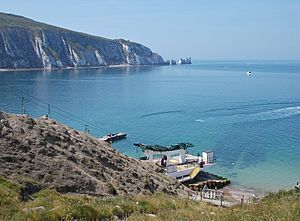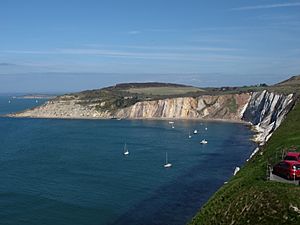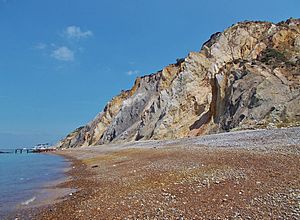Alum Bay facts for kids

Alum Bay is a beautiful bay located at the western tip of the Isle of Wight, England. It's very close to the famous the Needles rock formation. This bay is special because of its amazing multi-coloured sand cliffs, which are a big draw for tourists and scientists alike.
The waters and seabed around Alum Bay are part of a special protected area called the Needles Marine Conservation Zone. The land above the cliffs, including the shore and heath, is also protected as a Site of Special Scientific Interest (SSSI). This means the area is important for its unique geology and wildlife.
Contents
Discovering Alum Bay's Geology
Alum Bay is like an open book for geology students. Here, you can see very old layers of soft sands and clays. These layers were formed during the Paleocene and Eocene periods, millions of years ago. Below them, you'll find even older white chalk rock from the Cretaceous period.
What makes the cliffs so interesting is how the rock layers are tilted. Huge forces from the Alpine orogeny (a mountain-building event) pushed and folded the land. This caused the rock layers in the main part of the bay to stand almost straight up! The sands get their many colours from different iron compounds, which are like natural rust, formed under various conditions over time.
Alum Bay Chine is a small valley that leads down to the beach. It starts as a wooded area and then widens into a clay ravine. This is where the path and chairlift take visitors to the shore.
Fun Things to Do at Alum Bay
At the top of the cliffs, there's a fun amusement park. It has fairground rides, shops where you can buy souvenirs, and a cafe to grab a bite. During the summer, a chair lift offers a scenic ride down to the pebble beach below. If you prefer, you can also walk down to the beach using a footpath through Alum Bay Chine.
From the beach, you can take exciting boat trips. These trips often go out to tour the famous Needles rocks, giving you a fantastic view from the water.
The Famous Alum Bay Sands
For a long time, a popular souvenir from Alum Bay has been ornaments made with its colourful sands. People carefully layer the different coloured sands inside small vials and jars. In Victorian times, these sands were also used to create beautiful pictures, a craft known as marmotinto or sand painting.
In the past, visitors could actually climb the cliffs and dig out the sand themselves. However, to protect this special natural site, taking any minerals from the area is now against the law. Signs explain these rules because the site is part of a protected SSSI.
Today, at the Needles Park, there's a special place where you can still make your own sand bottles. The sand used there comes from natural rockfalls, so it's collected safely. You can even buy Alum Bay coloured sand by mail order to make your own creations at home!
Getting to Alum Bay
Southern Vectis bus services run to Alum Bay. In the summer, there are two special open-top bus services. One is called the Needles Tour, and the other is the Island Coaster service. Riding an open-top bus is a great way to see the beautiful scenery on the way to the bay.
A Glimpse into Alum Bay's Past
Around the year 1590, an old map of the area showed the bay with the name Whytfylde Chine. It's possible that a stream or small valley with this name once flowed into Alum Bay, but it has since worn away over time.
The sand at Alum Bay also contains very pure white silica. This special sand was once mined and used to make glass and pottery.
A famous inventor named Guglielmo Marconi came to Alum Bay in 1897. He wanted to experiment with early radio technology. He set up a tall, 40-metre radio antenna outside the Needles Hotel. At first, he managed to communicate with ships out at sea. By early 1898, he had successfully sent messages to stations in Bournemouth and Poole, which were about 20 miles away!





